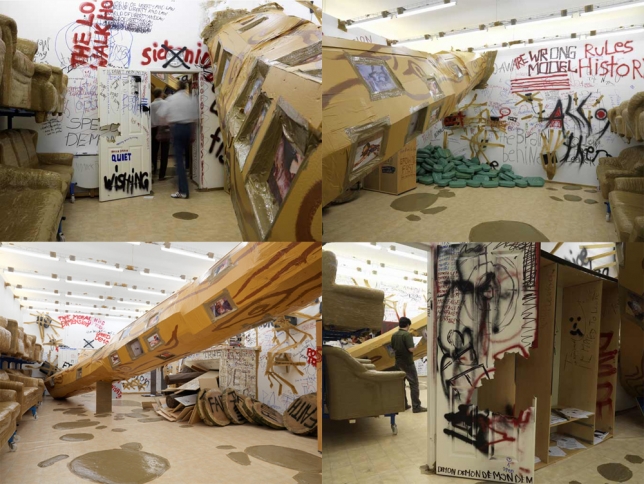27.04. – 07.07.07
Thomas Hirschhorn
“Stand-alone”
Solo exhibition at Arndt & Partner, Berlin
PRESS RELEASE
Arndt & Partner is pleased to present its fourth solo show of the Swiss artist Thomas Hirschhorn, to mark the opening of the Third Berlin Gallery Weekend.
Thomas Hirschhorn's sculptural constructions and environments are famous for transporting knowledge and information by alienating the usual means of presentation and skewing our perspective on things. To achieve this, Hirschhorn frequently favours elaborate, expansive installations, seemingly chaotic structures that use everyday materials that are nonetheless symbolically charged. Hirschhorn's spatial assemblages are skilful stagings of the imperfect, wild associative landscapes whose energies are intended to inspire thought, as Hirschhorn himself stresses: "I don't want to make interactive art, I want to make active art, work that activates the brain." The result are installations where the beholder has to engage with signs, symbols, and memories, and which change our perspective on the possibilities of art and life.
In Hirschhorn's new work "Stand-alone", which will extend over all four rooms of our Gallery 1st Floor, the beholder also is confronted with the richness of visual materials that is so typical for the artist, materials that make connections between apparently unconnected things. Kicked-in doors, sofas and armchairs wrapped in tape, are made equal by their wrapping and placed next to each other. Cardboard fireplaces, old electronic devices, wood, clocks, books, and other documents form a spatial collage, the purpose of which is "to create a new world from elements of the old one." Without pretension and exceedingly cleverly, Hirschhorn succeeds in creating a sense of profusion, chaos, and the potential of conflict that goes hand in hand with the experience of current life worlds.
In his latest exhibition, Thomas Hirschhorn is showing a three-dimensional realisation of his plan "Where do I stand? What do I want?" (which is available for visitors of the gallery) that thematizes the question of the artist's own position, possibilities of giving form, and independence in terms of content. "How can I make a work that doesn't in any way subject itself to historical facts? And how can I make a work that touches the beyond of history (which I live in)? How can I make in the current - my historical filed - make a super-historical work?"
Faithful to his unique way of giving form, the confusing architecture of his latest installation follows its own artistic logic. And if apparently excessive demands are raised to a principle of form giving, this is informed in Hirschhorn by a concept, because "chaos is the world in which I live, and chaos is the time in which I live," as he explains. Art, on the other hand, for him is a tool "to get to know the world, to confront it, to experience the age in which I live."
The choice of materials is also a conscious political decision. The cheap product packaging materials of the consumer goods industry for Hirschhorn are an appropriate, stringently used means of expression for his socially critical art. In them, his resistance against cultural grievances is articulated, as is a revolt against capitalisms desires, which Hirschhorn translated into a state of permanent creative anarchy. Available in every household, because of their everyday familiarity they avoid any appearance of exclusiveness, and thus underline the inclusion of the beholder which is so important to Thomas Hirschhorn: "Stand-alone is, as always, made for a non-exclusive audience, and as always, I want to include without neutralising, I don't want to exclude anybody."
With "Stand-alone", Thomas Hirschhorn once again reveals his ability to translate, through his aggressive visual worlds, political ideas and philosophical language into an accessible understandable language, to create reference and literally create new spaces for ideas and engagements. The result are art productions that make no aesthetic claims, but instead call for confrontation and dialogue about existing conditions, and which the New York Times considers "some oft the best being made today."
Thomas Hirschhorn was born in 1957 in Berne; from 1978 to 1983 he was a student at the Schule für Gestaltung in Zurich. Since the mid-1990s, he has gained international acclaim for his installations, and today he is considered one of the most important artists of his generation. He has been living and working in Paris since 1984. His works have been shown in countless solo and group exhibitions. He conceived and realised more than 50 works for public spaces.
